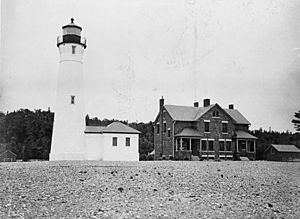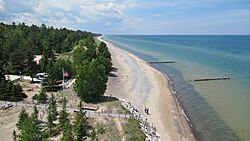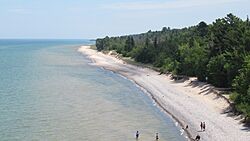Crisp Point Light facts for kids
| Location | Lake Superior shoreline McMillan Township, Michigan |
|---|---|
| Coordinates | 46°45.173′N 85°15.440′W / 46.752883°N 85.257333°W |
| Year first lit | 1904 |
| Deactivated | 1992-2013 |
| Foundation | poured concrete |
| Construction | brick |
| Tower shape | conical |
| Markings / pattern | White W/Black Lantern |
| Height | 58 feet (18 m) |
| Focal height | 62 feet (19 m) |
| Original lens | Fourth Order Fresnel lens |
| Range | 13 nautical miles; 24 kilometres (15 mi) |
Crisp Point is a historic lighthouse located on the shore of Lake Superior in Michigan. It was once one of five important stations that helped save lives along this part of the lake. The lighthouse is found in McMillan Township, within Luce County.
Crisp Point is about 14 miles (22.5 km) west of Whitefish Point. In 1876, it became "Life Saving Station Number Ten." This station was part of the United States Life-Saving Service, a group of brave people who rescued sailors and ships in trouble. The point is named after Christopher Crisp, one of the station's keepers, who was known as a very strong boatman. The people who worked there, called surfmen, were always ready to help. In 1915, the Life-Saving Service joined with the United States Coast Guard. Later, in 1939, the U.S. Lighthouse Service also became part of the Coast Guard. Originally, the Crisp Point Life Saving Station and the Crisp Point Lighthouse were two separate operations.
Other nearby life-saving stations included Vermilion Point, about 5 miles (8 km) east of Crisp Point, and Two Hearted River, about 5 or 6 miles (8 or 9.7 km) west. Further west were Deer Park (also known as Sucker River Station) and Grand Marais.
Contents
History of Crisp Point Lighthouse
The idea for Crisp Point Lighthouse was first suggested in 1896. It took several years, but construction finally began in 1903. The land for the lighthouse, about 15 acres (6 hectares), was bought for $30.00.
The lighthouse tower stands 58 feet (17.7 meters) tall from its base to the top of the lantern. Inside the tower, a special red Fresnel lens was installed. This type of lens, made in Paris, France, helps to focus the light so it can be seen from far away. The light first shone in May 1904.
Protecting the Lighthouse from Erosion
Over the years, the Crisp Point Lighthouse and its life-saving station faced a lot of damage from the weather and the lake. Most of the original buildings were destroyed by erosion, which is when water and wind wear away the land. Only the lighthouse tower and one wall of the entrance room remained.
To protect the tower, large amounts of stone have been placed in front of it. In the winter of 1997-1998, about 1,000 cubic yards (765 cubic meters) of stone were added. More stone was placed along the shore in 2003, 2006, 2007, 2010, 2016, and 2017. There are ongoing plans to add even more protection as money becomes available.
Shipwrecks and the "Shipwreck Coast"
The area of Lake Superior between Whitefish Point and Grand Island is known as "The Shipwreck Coast." Many ships have been lost here due to severe storms.
One famous shipwreck happened on November 10, 1975, when the SS Edmund Fitzgerald sank during a violent storm. It went down in Lake Superior about 17 miles (27 km) northeast of Crisp Point. The Fitzgerald's last radio message was to the Coast Guard station at Grand Marais.
Other ships also faced trouble near Crisp Point. On December 1, 1908, the large steel freighter SS D.M. Clemson disappeared without a trace somewhere between Crisp Point and Grand Marais. During the Great Lakes Storm of 1913, the freighter Major was stranded near the point. Also, the ship William Nottingham lost three men in the area when their lifeboat overturned while they were trying to get help.
Restoring Crisp Point Light
The Crisp Point Light was almost completely lost due to neglect and the harsh weather. The original boathouse, barn, oil house, and other buildings were also destroyed. In 1993, the U.S. Coast Guard officially stopped using the lighthouse.
In February 1997, ownership of the lighthouse was given to Luce County. This happened under a law called the National Historic Preservation Act of 1966. The Crisp Point Lighthouse was then leased to the Crisp Point Light Historical Society. This group works to preserve and care for the lighthouse.
In 2012, the Historical Society received permission to operate a light in the tower again. A new LED marine light was installed on November 23, 2012. On May 4, 2013, the light was turned back on and has been operating seasonally ever since.
Crisp Point Today
Today, Crisp Point Light is a place of renovation and renewal. The Crisp Point Light Historical Society and other groups regularly hold events at the site. The lighthouse, which was once on a "Doomsday List" of endangered places, has been brought back to excellent condition.
The service building that was destroyed in 1996 has been rebuilt. A visitor center has also been constructed next to the parking lot. This center has restrooms, a small gift shop, and a little museum. A fourth order Fresnel lens has been loaned to the society for display.
In the summer of 2016, a major restoration of the tower's exterior bricks was completed. All the old paint was removed, the brickwork was repaired, and then the tower was repainted white. This work was funded by money raised by the Historical Society and a grant of $25,000 from the Michigan Lighthouse Assistance Program. More stone was also placed in front of the boardwalk on the east side of the lighthouse to protect the shoreline from further erosion. The Historical Society completed some interior renovations of the tower in 2017.
See also
- Graveyard of the Great Lakes
- Lighthouses in the United States
- List of lifesaving stations in Michigan
- Shipwrecks of the 1913 Great Lakes storm




